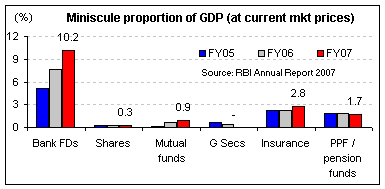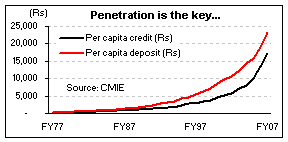In a move to slam brakes on the flows of anonymous foreign capital, the Securities and Exchange Board of India proposed a number of restrictions that will effectively spell doom for the thriving participatory note activity in the stock market. While the gyration of the benchmark indices on the bourses in response to this development was well anticipated, what we failed to reckon is the necessity of retail investors to panic in such situations.
The fact that we are uncomfortable with the BSE Sensex moving up to 19,000 levels and are not particularly jubilant at stocks meeting their three-year target prices at an unusually feverish pace has been adequately cited by us in the past. What we herein wish to explain is the rationale as to why keeping one's serenity at such times, yields favourable results in the longer term.
Current investment scenario
A noteworthy feature of the ongoing structural transformation of the Indian economy is the significant increase in domestic saving and investment rates. Domestic investment rate increased from 24.3 per cent in FY01 to 33.8 per cent in FY07 and domestic saving rate from 23.7 per cent in FY01 to 32.4 per cent during FY07. The household sector continued to be the major contributor to gross domestic saving with its saving rate placed at 22.3 per cent in FY07, while on account of rise in profit, the saving rate of private corporate sector rose to 8.1 per cent in this fiscal.
The public sector, which started posting positive saving beginning FY04, recorded a saving rate of 2.0 per cent in FY07 on account of continuing fiscal improvement as against a negative saving rate of 1.7 per cent in FY01. However, it may be noted that over 95 per cent of investment is financed by domestic savings.
Given the fact that Indian per capita income is increasing rapidly and policy efforts towards financial deepening for achieving a more inclusive growth are underway, savings rate in India could even rise further in the medium to long term. It is also expected that the level of saving rates should help continue to finance the investment needs of the economy domestically, without undue dependence on foreign savings.
But more importantly, one needs to look at the composition of such investments rather than just at the larger picture. Despite having one of the most advanced systems in place for trading in equities, Indians invested barely 6.2 per cent of their total corpus in equity and equity-related instruments (mutual funds) in FY07.

Exposure to equities
At the end of June 2007, demat accounts with premier depository National Securities Depository Ltd stood at 8 m while that the other depository Central Depository Services Ltd was 2.3 m accounts, making the total demat accounts in the country at over 10 m (0.003 per cent of the population living in urban areas). Further, there are over 1.1
Despite the fact that financial services accounted for nearly 14 per cent of the country's GDP in FY07, equities and mutual funds formed barely 1.2 per cent of the GDP (at market prices) in FY07. As against this fixed income securities such as bank FDs, PPF and pension funds formed a sizeable 11.9 per cent of the GDP.

Penetration issues The fact that the lending rates moved to considerably lower range in the past decade (despite the recent hardening) led to higher incremental demand for credit (incremental credit deposit ratio was over 100 per cent in FY06 and over 90 per cent in FY07), which in turn impacted the penetration levels.
The fact that the lending rates moved to considerably lower range in the past decade (despite the recent hardening) led to higher incremental demand for credit (incremental credit deposit ratio was over 100 per cent in FY06 and over 90 per cent in FY07), which in turn impacted the penetration levels.
To put things in perspective, while 70 per cent of the total bank credit was lent at rates between 14 per cent and 18 per cent per annum in FY01, less than 10 per cent of the bank assets are locked at such high rates today.
However, the penetration statistics reveal a different story if you look at the per capita accessibility of credit. Despite the credit growth in FY06 and FY07 being robust for banks, the same merely helped the growth in per capita distribution of credit rather than credit per branch.
Although the historical trend shows a direct association between the two variables, they have moved in tangential directions over the last two fiscals. This implicates that there has been credit concentration rather than penetration. The same holds true for exposure to equities, which having increased in absolute terms, have nonetheless, remained concentrated in a few hands.
Existing low penetration levels, increasing affordability of credit and rising income levels have led to a growing demand for retail financial products, leaving India with a substantial retail investor base having a large pool of untapped surplus funds. The same, we believe has the potential to replace the 'anonymous foreign capital' (through P notes), in case the latter chose to take a flight back to their source destinations.
Credible stock research with incredible offers. Visit Equitymaster.com for buy and sell investment ideas on stocks. Get free gifts too!





